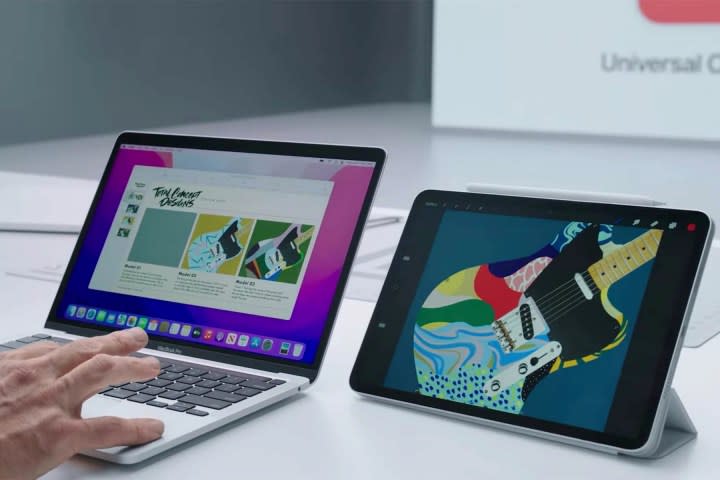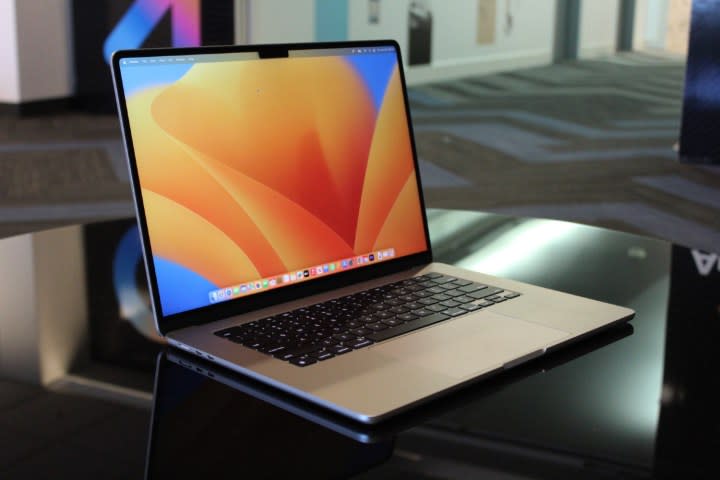Every few months, we hear the same argument being made: Apple should bring the Mac and the iPad closer together — or even merge them and their operating systems completely — to create some sort of hybrid device that would solve all of Apple’s problems. While I don’t entirely agree with these assessments, they do provide an interesting look into how your Apple devices might work in the coming years.
Bloomberg’s Mark Gurman is the latest to throw his hat into the ring, and the reporter’s Power On newsletter has detailed what he believes Apple should do to shape the future of the Mac and the iPad.
For one thing, Gurman believes that Apple should outfit the Mac with an OLED display and touchscreen functionality. For another, he advocates for the iPad to gain “a much better operating system” and the ability to run Mac apps.
There are some compelling points in there, and I definitely agree that the Mac range should come with OLED screens now that we’ve seen the quality Apple has infused into the iPad Pro’s Ultra Retina XDR display. And while I don’t think it would be a good idea to load macOS onto the iPad (the operating system is just not designed for touch interfaces), I think the iPad should get some Mac apps in certain circumstances — Mac games would be a good addition, for example, particularly since many iPads and Macs use the same Apple silicon chips.
Touchscreen trouble
Yet not everything in Gurman’s report feels like it’s on the money. In particular, we’re retreading familiar ground when it comes to touchscreen Macs, as Apple has repeatedly said that it doesn’t want to make this kind of device.
There are a few reasons for that. First, Apple has been saying for years that it thinks touchscreen laptops are an ergonomic nightmare. And secondly, this would be extremely expensive tech to research. You know Apple, so its touchscreens will have to be the best, most all-singing, all-dancing panels in the industry, bar none. Yet, it would be spending all this money on something it has continually said its customers aren’t interested in. That just doesn’t seem like a viable business plan.
And yes, I’m aware there are reports that Apple is testing a touchscreen-enabled Mac for release in 2025. Does that mean it’s actually going to happen, though? Not necessarily. Apple tests ideas all the time — we’ve heard reports of an Extreme-tier Apple silicon chip and seen patent filings for curved, all-glass iMacs — but that doesn’t mean they’re anything more than experiments deep in Apple’s top-secret labs. Bringing them to market is an entirely different ball game.
If Apple does go touchscreen, I highly doubt it will come to all (or even most) Macs. A more likely scenario is that it will be a high-end option for the MacBook Pro, maybe even an add-on like the iPad Pro’s nano texture glass. If you’re desperate for a touchscreen Mac, this is the one way I can see it happening. But given what Apple has already said about this kind of device, I wouldn’t be surprised if this never happens.
The same, but different?

To bolster his argument, Gurman says that “at some point, customers are going to get tired” of not having features like Mac apps on the iPad or a touchscreen panel in the MacBook. But do we actually know that?
The second-quarter results Apple released just a couple weeks ago seem to suggest otherwise. The company’s iPad sales were down, yes, but we can largely chalk that up to Apple not launching a new tablet for over a year. Now that the range has been refreshed, Apple expects iPad sales to grow by “double-digits” next quarter. Meanwhile, Mac sales increased 4% and revenue was higher than expected, while Mac customer satisfaction was a huge 96%. I don’t know about you, but to me, that doesn’t exactly look like customers are getting tired of the status quo.
Gurman also says that the Mac and the iPad can still be different. “The Mac will always have more powerful chip options, larger displays, a built-in keyboard and trackpad, fans for heavy workloads, more ports, and better battery life,” he asserts. “The iPad will always be far more portable, better for gaming, superior for watching video, and a device that can capture photos and video.”
But even there, I’m dubious. The Mac is surely better for gaming given its more potent chips, while I think we can all agree that very few people actually use iPads to take photos and videos on a regular basis. If these differentiating features aren’t actually all that differentiating, it just highlights the risks of making the two products too similar.
Don’t bet the farm

I’m not saying we should totally discount everything Gurman is saying about the iPad and Mac moving a little closer together. The OLED display is almost certainly coming to the Mac, as Apple used a similar playbook when it first introduced mini-LED screens: they started in the iPad Pro, then came to the Mac later. We can expect the same with OLED.
But Apple needs to be very wary about bringing the iPad and Mac too close together, as it’s seen exactly what can occur — just look at how the iPhone made the bestselling iPod obsolete in a few short years.
As it happens, that situation ended very well for Apple, but is there any guarantee of a repeat performance? At the moment, Apple will be extremely happy with its iPads and Macs: sales are up or set to rebound, customer satisfaction is incredibly high, the money is rolling in. Why change a winning formula?
So, while Gurman’s report highlights one potential future for these devices, I wouldn’t bet the farm on it coming to pass. While I agree with some of what he says, there’s just very little incentive for Apple to bring the Mac and the iPad too close together.
Signup bonus from




